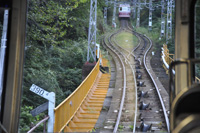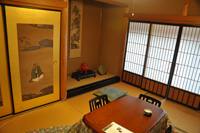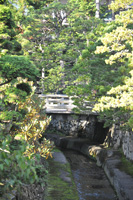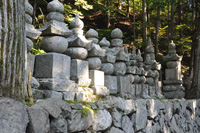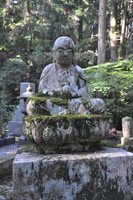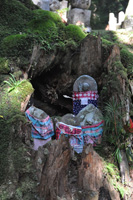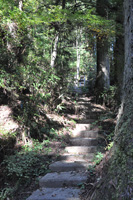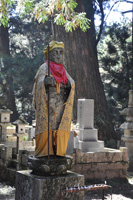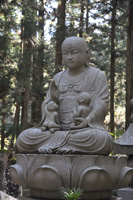 Without a question these will go down as some of the more interesting days of my life. The tug of attachment as I left Nagasaki suggests that, at the very least, that stop alone will make this trip memorable. After a five hour trip on the Shinkansen I spent the better part of an hour in the almost English-free atmosphere of Osaka where I stayed calm amidst the confusion of multiple train lines and city loops before I got a read on how to get to Koyasan. I was mindful of being in a series of moments where I was looked at as different and with curiosity. Osaka presented more of a cross section of Japanese life than what I saw in Tokyo, with a much younger crowd.
Without a question these will go down as some of the more interesting days of my life. The tug of attachment as I left Nagasaki suggests that, at the very least, that stop alone will make this trip memorable. After a five hour trip on the Shinkansen I spent the better part of an hour in the almost English-free atmosphere of Osaka where I stayed calm amidst the confusion of multiple train lines and city loops before I got a read on how to get to Koyasan. I was mindful of being in a series of moments where I was looked at as different and with curiosity. Osaka presented more of a cross section of Japanese life than what I saw in Tokyo, with a much younger crowd.
Before leaving the station in Shin-Imamiya I had a conversation with a Japanese high schooler whose name sounded like Kobo Daishi (I'm sure it was Kobayashi) who wanted to work on his English and help me get to my destination. He was going to Koyasan too, but on a train with multiple stops. I was reminded of what I was like at that age: engaging with adults and yet a bit wobbly. He said my name again as we shook hands, and I thought his name sounded familiar. In the matter of moments we were friends, and as I looked out he was waving to me as the train pulled away.
 The train ride south through the Osaka suburbs showed a more industrial side that I was eventually expecting to see. As the train headed into the hills I was thinking how much the terrain looked like Elk County, PA. Then we pulled out of a tunnel into alpine territory and a slow climb to our final destination: the UNESCO designated World Heritage Site of the Mt. Koya Temple complex. Upon arriving at my first temple I was immediately immersed in a most authentic experience of Japanese life. Within the span of a few hours I took in my first Buddhist meditation, a nine course meal with English speaking pilgrims, and a bath with temple monks and pilgrims. Tomorrow will either be a downer or will again exceed expectations. This place is getting under my skin to a degree which has almost left me dumbfounded.
The train ride south through the Osaka suburbs showed a more industrial side that I was eventually expecting to see. As the train headed into the hills I was thinking how much the terrain looked like Elk County, PA. Then we pulled out of a tunnel into alpine territory and a slow climb to our final destination: the UNESCO designated World Heritage Site of the Mt. Koya Temple complex. Upon arriving at my first temple I was immediately immersed in a most authentic experience of Japanese life. Within the span of a few hours I took in my first Buddhist meditation, a nine course meal with English speaking pilgrims, and a bath with temple monks and pilgrims. Tomorrow will either be a downer or will again exceed expectations. This place is getting under my skin to a degree which has almost left me dumbfounded.
 Mount Koya is the name of mountains in Wakayama Prefecture to the south of Osaka. There is no one mountain officially called Koyasan in Japan. First settled in 819 by the monk Kobo Daishi, or more popularly, Kūkai, Mt. Kōya is primarily known as the world headquarters of the Koyasan Shingon sect of Japanese Buddhism. Located in an 800m high valley amid the eight peaks of the mountain (which was the reason this location was selected, in that the terrain is supposed to resemble a lotus plant), the original monastery has grown into the town of Koyasan, featuring a university dedicated to religious studies and 120 temples, many of which offer lodging to pilgrims.
Mount Koya is the name of mountains in Wakayama Prefecture to the south of Osaka. There is no one mountain officially called Koyasan in Japan. First settled in 819 by the monk Kobo Daishi, or more popularly, Kūkai, Mt. Kōya is primarily known as the world headquarters of the Koyasan Shingon sect of Japanese Buddhism. Located in an 800m high valley amid the eight peaks of the mountain (which was the reason this location was selected, in that the terrain is supposed to resemble a lotus plant), the original monastery has grown into the town of Koyasan, featuring a university dedicated to religious studies and 120 temples, many of which offer lodging to pilgrims.
 The mountain is home to the following famous sites: Okunoin, the mausoleum of Kūkai, surrounded by an immense graveyard (at 500,000+, the largest in Japan); Danjogaran, a heartland of Mt. Kōya; Konpon Daitō, a pagoda that according to Shingon doctrine represents the central point of a mandala covering not only Mt. Kōya but all of Japan; and Kongōbu-ji, the head temple of the Kōyasan Shingon Buddhism. In 2004, UNESCO designated Mt. Kōya, along with two other locations on the Kii Peninsula, as World Heritage Sites.
The mountain is home to the following famous sites: Okunoin, the mausoleum of Kūkai, surrounded by an immense graveyard (at 500,000+, the largest in Japan); Danjogaran, a heartland of Mt. Kōya; Konpon Daitō, a pagoda that according to Shingon doctrine represents the central point of a mandala covering not only Mt. Kōya but all of Japan; and Kongōbu-ji, the head temple of the Kōyasan Shingon Buddhism. In 2004, UNESCO designated Mt. Kōya, along with two other locations on the Kii Peninsula, as World Heritage Sites.
While staying at Temple Rengezyo-in, I was able to participate in their daily services. Each was well-attended by temple guests, and the morning service consisted of the chanting of sutras by the monks. The tone initially seemed monotone and gutteral, but as I listened I could discern distinct and complex harmonies. Instead of the half and whole step note intervals we hear in western music, their intervals sounded closer together. There were gongs and cymbals and other kinds of bells. It felt like the rarest of experiences. It was very beautiful, and the atmosphere lent itself to my own meditation.
After each service the head priest gave a long talk in both Japanese and English on the history of the area and some of the teachings of the Shingon sect. He was informative and gave no sense that they were looking to make converts. After the evening meal, his ninety year old mother gave a talk about what it was like to grow up in this part of Japan, to leave for school in Tokyo, and then to return to rebuild the community after the war. These talks introduced me to the practice of these local temples often being passed down through families.
 Simply put, syncretism is the bleeding of religious beliefs or practices, one into another religion. It is the well-founded belief that the religious practice of a community can be watered down as it comes in contact with other religions or cultural influences. But then what happens when a religious system is too closed? Christ did not wait until people were at a certain point before he entered into a relationship with them. The closed system risks the failure to reach out to people and to befriend them as they are.
Simply put, syncretism is the bleeding of religious beliefs or practices, one into another religion. It is the well-founded belief that the religious practice of a community can be watered down as it comes in contact with other religions or cultural influences. But then what happens when a religious system is too closed? Christ did not wait until people were at a certain point before he entered into a relationship with them. The closed system risks the failure to reach out to people and to befriend them as they are.
Too much of the way we interact with people is based on black and white, all or nothing thinking. This is what happens when the concern for confessional boundaries slips into a seige mentality. When we look at definable religious traditions it is possible to see fundamentalist strands in each. Significant study corroborates this.
For me, addiction is the model which best speaks to the phenomenon of black and white thinking. We have to have things a certain way because we can't handle life's loose ends. We like a clean slate.
Genocide and sophisticated weaponry, used to meet political ends, are a way of wiping the slate clean. But the all or nothing thinking we see in political life is also seen in religious circles. It is true that sometimes our backs are against the wall and we feel like we have to fight for our beliefs or a certain way of life, but we are too quick to say we are at that point. Religion really can be an opiate. It can be a way to preserve a certain state of mind. It can be a mechanism for avoiding the realization that life is messy and even ugly at times. Complexity is a fact of life; it can be seen as a hurdle or a benefit. Belief is a fix for a lot of people.
This has been more of an emotional experience than I had expected. I thought it would be interesting and productive, but it has been so much more. I find little things tugging on me emotionally more than I can recall in recent memory. Prayer has felt more sincere and concerned for the needs of random people I meet on this trip. I am grateful to be on the other side of the world with a different people. I feel a new unity with the human race in all its differences. Perhaps it's a function of being on vacation, but for as foreign as all of this would seem I feel very comfortable here. This is true even of moments that would ordinarily be quite awkward.
 Yesterday I hesitated, but this morning at the conclusion of Goma prayers while the head monk remained ensconced I approached, bowed, and sat down as everyone else left. I expressed my gratutude for the experiences in Koyasan and told him why I was visiting. We then had a conversation about meditation, mutual techniques and teachings upon which we rely, and the goals which we seek. He acknowledged something which was gratifying to hear: that different religions are seeking the same enlightenment through different paths. "Different paths, different doors, same enlightenment".
Yesterday I hesitated, but this morning at the conclusion of Goma prayers while the head monk remained ensconced I approached, bowed, and sat down as everyone else left. I expressed my gratutude for the experiences in Koyasan and told him why I was visiting. We then had a conversation about meditation, mutual techniques and teachings upon which we rely, and the goals which we seek. He acknowledged something which was gratifying to hear: that different religions are seeking the same enlightenment through different paths. "Different paths, different doors, same enlightenment".
He expressed surprise when I told him that I am a priest, and without prompting he began to talk about the difficulty of being a priest in his community. I could sense frustration and the reminder of particular concerns. "It does not matter what kind a priest you are, there is always anxiety. There is always anxiety. We all have enormous responsibility, but it is ours to carry out". He talked about how he has brought reform to his community and clarification of the principles of Kobo Daishi and how difficult it has been. The priest could not have known what work I did on retreat in Nagasaki, so when he talked about his work being a being a process of transfiguration, for him and his community, I asked him what he meant. He suggested that the process of enlightenment is one of renewal and illumination, which seems similar to the insight I came to on retreat.
 While in Koya I was assigned a monk host who greeted me, showed me around, checked on me, and generally helped with any questions I had. I never knew his name, and even if I asked I forgot it. His initial response to every question was to give an emphatic no and then laugh nervously. Later he would come back with the real answer after apologizing that he really didn't know. Yesterday I asked about the possibility of staying another day and he said it was impossible. After breakfast today, as I was checking out, he asked "You want to stay another day?" I really wanted to, but I knew I might miss out on another important experience at my next stop. We exchanged a series of bows while walking out of the shukubo. I didn't know when the bowing was supposed to end. My host followed me bowing until I had to turn and leave, and just at that moment he knelt down and prayed. So I did the same. It was so hard to go. I am so moved by the many things that happened in Koya, and by the subtleties of my feelings.
While in Koya I was assigned a monk host who greeted me, showed me around, checked on me, and generally helped with any questions I had. I never knew his name, and even if I asked I forgot it. His initial response to every question was to give an emphatic no and then laugh nervously. Later he would come back with the real answer after apologizing that he really didn't know. Yesterday I asked about the possibility of staying another day and he said it was impossible. After breakfast today, as I was checking out, he asked "You want to stay another day?" I really wanted to, but I knew I might miss out on another important experience at my next stop. We exchanged a series of bows while walking out of the shukubo. I didn't know when the bowing was supposed to end. My host followed me bowing until I had to turn and leave, and just at that moment he knelt down and prayed. So I did the same. It was so hard to go. I am so moved by the many things that happened in Koya, and by the subtleties of my feelings.
